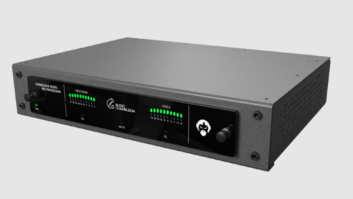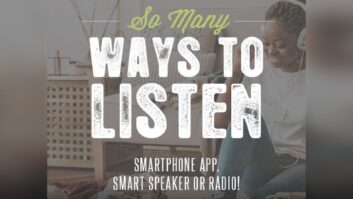AM REVITALIZATION
Guy Wire’s opinion piece (“iHeartMedia Makes a Preemptive Strike,” Dec. 2) offers some new perspective and invites comment.
The classic picture of the heritage station covering 34 states is romantic, but its fabric is torn by reality. With a few notable exceptions, today’s 1-A stations are committed to competing in their local markets against the big FMs. Therefore the idea that rural- and remote-area service justifies nighttime protection of those signals is hard to justify.
However … if skywave protection is reduced, the commission should allow only the consequent existing-station upgrade opportunities. No new AM stations should be licensed on these channels. The goal of “saving the occupants of the AM band” will not be furthered by adding additional occupants.
The goal of “enhancing localism” should be put to sleep once and for all. Docket 80-90 taught some folks this lesson. New AM stations (likely multi-tower) would be built at minimum investment and would probably be automated. And the public would be no better served with emergency warnings and public-service information.
I’m also curious about what a reduction/removal of skywave protection might do to the IBOC picture. The current coverage ratios between adjacent 1-A stations (see: Chicago/New York, et. al.) have led some 1-As to shut down their digital pollution. How would that change in an environment where 1-As had less nighttime protection?
As to numbers, Guy’s call for “more data” is important, but we know numbers can be massaged to prove almost anything. Having suggested that, ratings are key numbers, and I believe the 1-As that still deliver high listenership got there by investing in solid programming and resources.
Those investments should be protected; but it’s hard to make the case that noise-free AM reception should be protected beyond the contours of interference-free protected FM service.
Mark Durenberger, CPBE
Minneapolis, Minn.

iStockphoto/alengo Interesting proposal from the FCC on potentially reducing nighttime and critical hours skywave protection for the big 50KWs in order to let local AM stations shine at night (“FCC Acts to Give AM Operators Relief,” Nov. 4).
I’m for it (despite the fun I used have pulling in long distance station at night), if the locals truly fill in the news and info gap during an emergency that the big stations can give. The big regional stations aren’t that necessary any longer to cover big geographic areas. Getting FM translators for the little AM operators would be helpful, too.
David McAlary
Volunteer radio producer
Fairfax Public Access/Retired editor, newscaster and correspondent
Voice of America
Falls Church, Va.
In my neighborhood, the AM radio dial is 90 percent talk, especially right-wing talk aimed at angry seniors. And there are two stations that play Mexican music. All stations come in clear as a bell most of the time.
My younger neighbor (who is in the coveted demographic) has a dusty 1937 Philco console that hasn’t worked in a decade but he has an iPod hooked up in the cabinet that plays big band and doo wop music. His other radios are all FM.
I asked him if he would consider fixing up the radio if there was a big band or doo wop station to listen to. He jumped at the idea and smiled widely at the thought.
So who’s the brain who decided that you can play music on AM, but only if it’s Mexican oom-paa-paa?
And moving all that talk to FM will accomplish one thing: Lots of people will leave there too.
Duke Evans
Santa Rosa, Ca.
I have followed this plan with the FCC since it was announced several years ago (“FCC Acts to Give AM Operators Relief,” Nov. 4).
My interest is personal since I worked for a stand-alone owner of an AM/FM operation. My almost 30 years there meant nothing as he sold the stations for a tidy profit. Eventually, the new owners moved the FM to another county and he repurchased the AM, which he continues to operate. Now with this new plan he will be awarded an FM translator? This really seems wrong to me.
He willfully sold the station and made a nice sum in the process. Now, along with his money in the bank he will also have a new FM.
Any way I try to process this, I see it as wrong. And I wonder how many other towns in the USA have a similar story?
Steve “Kelly” Anderson
Programmer/on-air talent
New Philadelphia, Ohio
AUDIO PROCESSING
I totally agree with Mike Erickson (“Take Steps to End the Loudness War,” Nov. 18).
We are a small radio group, but I push for no compressed audio in house and a transparent audio chain. Our staff is very aware of how good we sound, and when something is not right, it usually really sticks out, and we take care of it. Production and imaging easily can over process if not careful and when that goes through, on-air processing can really stand out.
Most of the big commercial production studios for national spots do a real good job and might be a good reference to keep in check. Plugins like Ozone can be great, but you can also ruin audio with them as well.
You must use your ears.
I keep some audio files that I really like in a folder to go back and listen to from time to time. Also, I have had to educate folks that when you get an MP3 and convert it to a WAV, you did not just fix the problem… the problem was created when it was first made into an MP3.
That’s my 2 cents.
Bruce Roberts
Director of Engineering
Apex Broadcasting
Charleston, S.C.












